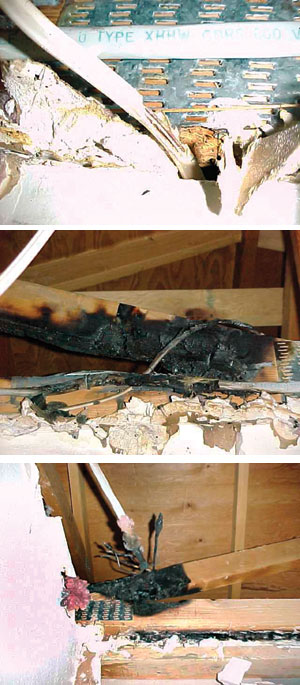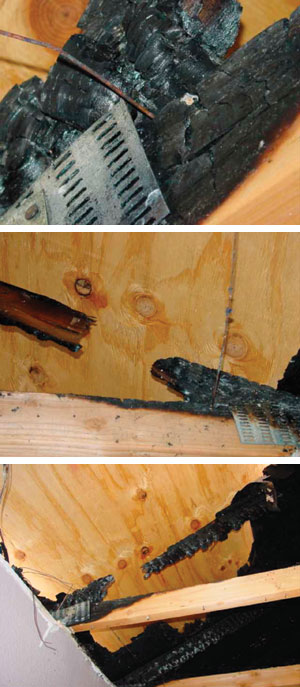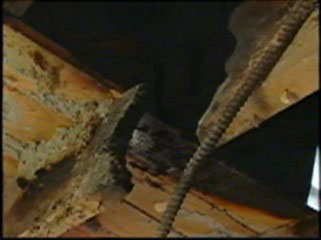We should all be champions of electrical safety and strive to ensure that our customers, our friends and our families do not experience the worst that electricity has to offer. In the words of Wesley Smith of Mount Lebanon, Pennsylvania, who almost had a major incident, “Fire is something that you definitely don’t want to have happen to you, and it’s something that could have easily happened (to me). But since I had an experience that made me very aware, I wouldn’t put in another circuit unless it was protected with an arc-fault circuit interrupter.” Mr. Smith is among many others who have experienced an electrical incident. Fortunately, in his case no lives were taken and no valuable property was lost. In this article, we will explore electrical fires and an update of the 2008 NEC adoption process across the United States. The incidents shared here are real and based on actual experiences.
The Electrical Fire

I have spoken to fire investigators who spend many hours sifting through debris after a fire, and I have spoken to homeowners who experienced an electrical fire firsthand in their homes. My insight to these discussions is that both perspectives, when married, tell the story. One without the other only gives you one perspective.
If we wanted to widen our vision into this problem, we could include input from other key individuals who deal with the aftermath of these events including firefighters, insurance companies, lawyers, and organizations like the Red Cross and many others.
In speaking with and hearing from a few fire investigators, I learned that apparently they do not see as many electrical fires as I had originally thought. One investigator told me that most electrical fires do not warrant an investigator because the cause is usually obvious. He provided much more insight though, as well as his books, to the theory behind fire and specifically electrical fires. Combining this understanding with the stories told by homeowners who experienced electrical fires and with pictures of electrical fire results provides a much better understanding of the problem and its effects.
Most of the events that I have witnessed or have been informed of include quite clear examples of electrical fires that did not warrant the calling of an individual who conducts full-blown investigations of these tragic events. One example of this includes a ceiling fan in my nephew’s bedroom. The event woke him and his parents were able to correct the issue before too much damage was incurred and more importantly before a life was lost. It was very clear that this event was electrical in nature, and no one was called to the scene other than those necessary to fix the problem. There is a good mix of electrical fires of which I am aware that either did or did not involve a fire department or insurance claims. Some have taken lives and when this occurs, a complete investigation is conducted. There are events that go undocumented, other than by personal pictures and word-of-mouth declaration of events. Those documented by a fire department are recorded in the National Fire Incident Reporting System (NFIRS) and become recorded statistics. In many cases, you don’t read about them in the daily newspaper or see them played out on television on the 11 o’clock news.
Electrical Fire Examples Explored

Eugene Bartel, an electrical fire investigator with a Ph. D. and a P. E., described it well: “If you have a wire that is damaged or frayed or succumbs to some failure mode and it does spark behind walls, it can ignite the face of insulation that is in the walls. It can ignite the paper that is on your drywall material. It can do anything behind the walls. Generally what that does, though, is that it produces a much slower progressing fire, because you are in a confined space that has little oxygen and what takes place is that it slowly smolders in there over time until it works its way out to available oxygen and fuel. Then it erupts into a full-blown fire. We’ve seen them travel along stud spaces and joist spaces from a basement up to an attic before it really erupted into a full-blown fire.” It is this combination of circumstances that makes these fires devastating. The way they spread while the homeowner is unaware of what is happening gives the problem time to prepare the surrounding material for ignition. These fires usually erupt when you least expect it, while you are sleeping.
What Rebecca Jacoby experienced was the predecessor to what Hank Mader of Pittsburgh experienced in his home, because her problem was detected and cleared by the AFCI device which was installed. Mader’s event was masked by some work that was going on at a neighbor’s house next door and his circuit was not protected by an AFCI circuit breaker. The odors that he experienced were attributed initially to his neighbors’ construction and so his electrical fire had the time necessary to smolder and spread to other areas of the house. As Mr. Mader explains, it was while he was putting on his work shoes that he determined something was wrong. “While I was sitting there, I heard like a pop—very, very faint—and then a little bit later than that a little bit of a crack.” These, too, are words that are commonly heard from victims of electrical fires. As Mr. Mader was on the phone calling the fire department, he noticed a puff of smoke pass in front of his window. He immediately left the house and the fire department was quick to respond. Chris Buttlar, a firefighter with the Mount Lebanon Fire Department, was first on the scene. He explained what he witnessed as he came to the home and described it as moderate smoke coming from an attic window. He goes on to explain, “There was a small fire in the attic that appeared to be centered above a lighting fixture. We put the fire out fairly quickly. We had a quick knock down.” It wasn’t until after they began to clean up that someone noticed smoke again coming from the attic. “We noticed some more smoke emanating from that area, from a different area which was a little bit off from the original fire. It was actually a different room but it was up in the attic. We couldn’t put the connection together because it was remote from where the fire was. We figured it had to be electrical and it was. What we found out was that it was following the path of the BX through the insulation.” What happened in Mr. Mader’s home is that the studs first began to warm and this warming developed into charring. The charring continued until it found the oxygen and other flammable items that it needed. The crackling and popping began and fortunately alerted the homeowner to the problem. Many are not as fortunate; they either awake to smoke-filled rooms, or they succumb to the smoke as they sleep.
In some of these cases, I had a hard time understanding why ignition didn’t occur earlier than it did. A fire investigator tried to explain to me how an electrical fire can warm and deteriorate the stud and take such a long time to ignite. It became very clear when he asked me if I was ever a Boy Scout and if I have ever tried to start a fire with a 2 X 12.
What he explained was that the wood has to experience a transformation before it finally erupts into flame. That stud will char and continue to smolder until it hits a material that has the right mixture of density to mass ratio and oxygen. Then you have a fire on your hands. I have spoken with firefighters who talked of walls that become chimneys from the basement to the attic, delivering intense heat and igniting the contents of the attic while the victims sleep in the rooms below. Firefighters will explain that people commonly die from smoke inhalation. Have you ever tried to escape from a smoke-filled room? I have not had that experience. . . nor do I ever want to!
How Electrical Fires Start
Ignition, and the susceptibility of solid materials to ignite, depends upon many factors. As this is such a complex topic, for those who are interested in nighttime reading material, “The Ignition Handbook” by Vytenis Babrauskas provides detailed examinations of all factors affecting ignition. This is surely a reference text that will provide more than you can imagine on this topic. When it comes to ignition, for a solid to burn, it must be volatilized. For ignition to occur, the material first must be capable of propagating self-sustained combustion. The warming, the heat, causes chemical bonds to break and the material to be decomposed into volatile substances which either ignite in the presence of a pilot or auto ignites. Auto ignition temperatures are usually over 500oC. It is more likely that the results of charring will ignite another item along its path. Keep in mind, arcing temperatures can exceed 10,000oC.
Solids exposed to heat will react in one of three ways. They will melt, dehydrate or char. Charring is something very important to fire investigators. The various items that char include wood and many thermosetting plastics. A thermosetting plastic is a polymer that does not melt or soften on exposure to heat. Circuit breakers and other similar electrical products are typically made of this type of plastic. It will maintain its original shape in high temperatures even after experiencing flames. Thermoplastics are those polymers that soften and deform on exposure to heat. Receptacles and other similar devices are typically made of this type of plastic.
Dehydration, mentioned above, is yet another reaction that many materials experience, and it occurs when water molecules that are chemically bound to larger molecules in the solid matrix are released by breaking the weak chemical bonds. Absorption of energy is involved here. For most solids, ignition occurs when small molecules are created and then driven off by an external heat source. These volatiles ignite and burn in air. This flaming combustion above the solid’s surface provides more heat for additional pyrolysis and volatilization. The solid left behind is known as char. Char can actually insulate the material below it from the heat source because char is generally less conductive than the solid from which it originated. Fire investigators like to use a char rate in their efforts to understand what happened. The insulating properties make determination of this charring rate difficult. This rate will change over time. Average charring rates have been determined for substances exposed to a calibrated energy source such as a furnace, but real fires are not calibrated. The charring rate of most common woods has been found to range between 0.5 and 0.8 mm/min as per ASTM E 119, Standard Test Methods for Fire Tests of Building Construction and Materials. In the Mader fire, the investigators noticed something about the studs. “Once we pulled the charred material out, it was basically a groove of wood that was missing. So to me, that typically tells me that that had been burning a long time. That wasn’t a char from a 10- or 15-minute fire. That char was hours or days old. (Maybe) weeks old,” said Chris Buttlar.

Photo 7. In the Hank Mader electrical fire, the installation included BX as shown
Understanding how solids char, knowing the insulating capabilities and the slow rate of char, helps us understand what was experienced here. What was experienced by Ms. Jacoby in her event becomes clearer. Fortunately, the AFCI breakers she had installed caught the problem early. These events saw the studs being warmed and there wasn’t enough time for charring to begin to take shape. In her incident, the fire did not get a chance to start. Mr. Mader was not as fortunate and extensive damage to his house was not avoided. His response is commonly heard from those who have experienced an electrical fire: “I thought a circuit breaker was a foolproof kind of a thing; that if you had an electrical problem, the thing is supposed to pop and solve your problem.” The images within this article illustrate even further the damaging effects of electrical problems. These images illustrate that electrical problems can occur anywhere in the circuit. We’ve heard examples here of problems near luminaires and in ceilings. Some of these images even illustrate problems in home run circuits, those circuits between the circuit breaker and the first receptacle. Problems also occur on the load side of the receptacle in connected cords and appliances. One thing certain about electrical fires and arcing is its unpredictable nature and devastating results.
Overcurrent Protective Devices
The thermal magnetic circuit breakers and fuse-type overcurrent protective devices need two things in order to trip: current and time. This mix is not typically provided by an arcing fault. The overcurrent protective device has a single purpose in life, which is to protect the conductors from overheating damage. This is why they are called overcurrent protective devices, and why current and time are necessary for them to open and clear the fault. The arc-fault circuit interrupter takes this protection to a new level by watching the waveforms for abnormal conditions. These abnormal conditions are arcing faults that can cause fires. These arcing faults can occur anywhere on the circuit as a result of being damaged. With the new combination-type AFCI, the protection includes both high- and low-energy arcing faults, commonly referred to as parallel and series arcing faults respectively. These arcing faults can be found anywhere along the circuit from its origination at the main load center to the end device that is plugged in. The devices that are plugged into the receptacle can have a problem too, and these problems can also be detected by combination type AFCIs located in the load center. The combination type AFCI products on the market today offer enhanced protection for installed wiring and connected cords. The acceptance of this device across the U.S. has been outstanding.
The NEC and Its Adoption
As code officials across the United States review the National Electrical Code, technologies like the AFCI and others are questioned. For those that have experienced electrical fires, or have experienced the loss of a loved one due to electrical shock, these requirements are obvious and should never be compromised. For others, the question of cost and effort challenge the requirements yet again. For technologies like the AFCI and GFCI, and now even tamper-resistant receptacles, the evidence and statistics usually provide enough background and justification to support their inclusion. Although these are technical products and how they function is sometimes difficult to explain, the end result of their purpose, for many, is all that matters. For Rebecca Jacoby, Wesley Smith, and Hank Mader, requiring AFCI protection on all 15-A and 20-A circuits in a home would be something they would support. These individuals understand the value because they have seen what can otherwise happen.
As I write, a few more states have reviewed and continue to review theNEC-2008.
Florida: The Florida Electrical Technical Advisory Committee (TAC) voted 8–1 to recommend to the Florida Building Commission that the 2008 edition of the National Electrical Code be adopted without amendment. The implementation date of NEC-2008 was August 1, 2009.
South Carolina: NEC-2008 went into effect in this state as of July 1, 2009, but smoke detectors were removed from the AFCI-circuit. South Carolina as well as a few other states have made this decision even in light of test data and reports from Underwriters Laboratories (UL) and Consumer Product Safety Commission (CPSC) that specifically address the misconception of incompatibilities between smoke detectors and AFCIs. It is a fact that these items are compatible with the AFCI protection technology and that the witness devices are no less susceptible to damage and causing a fire than any other circuit in the home.
Kentucky: The state of Kentucky is now on NEC-2008, enforcing AFCI, GFCI, and tamper-resistant receptacles, effective September 1, 2009.
Delaware, Michigan and West Virginia are soon to adopt NEC-2008; and probably by the time you read this article, they will have adopted NEC-2008 without amendment.
NEC2008 has had great acceptance across the United States and will continue this trend until the last state adopts. The 2011NECis right around the corner. We must continue the adoption success with this new version. It is important that we are all advocates of electrical safety and support the adoption of the latest version of the NEC in our individual states. IAEI is a great organization that is respected in our communities and by our lawmakers. Wear the IAEI brand with pride and stand as one voice to support the Code. It can and will make an impact on electrical safety.














Find Us on Socials